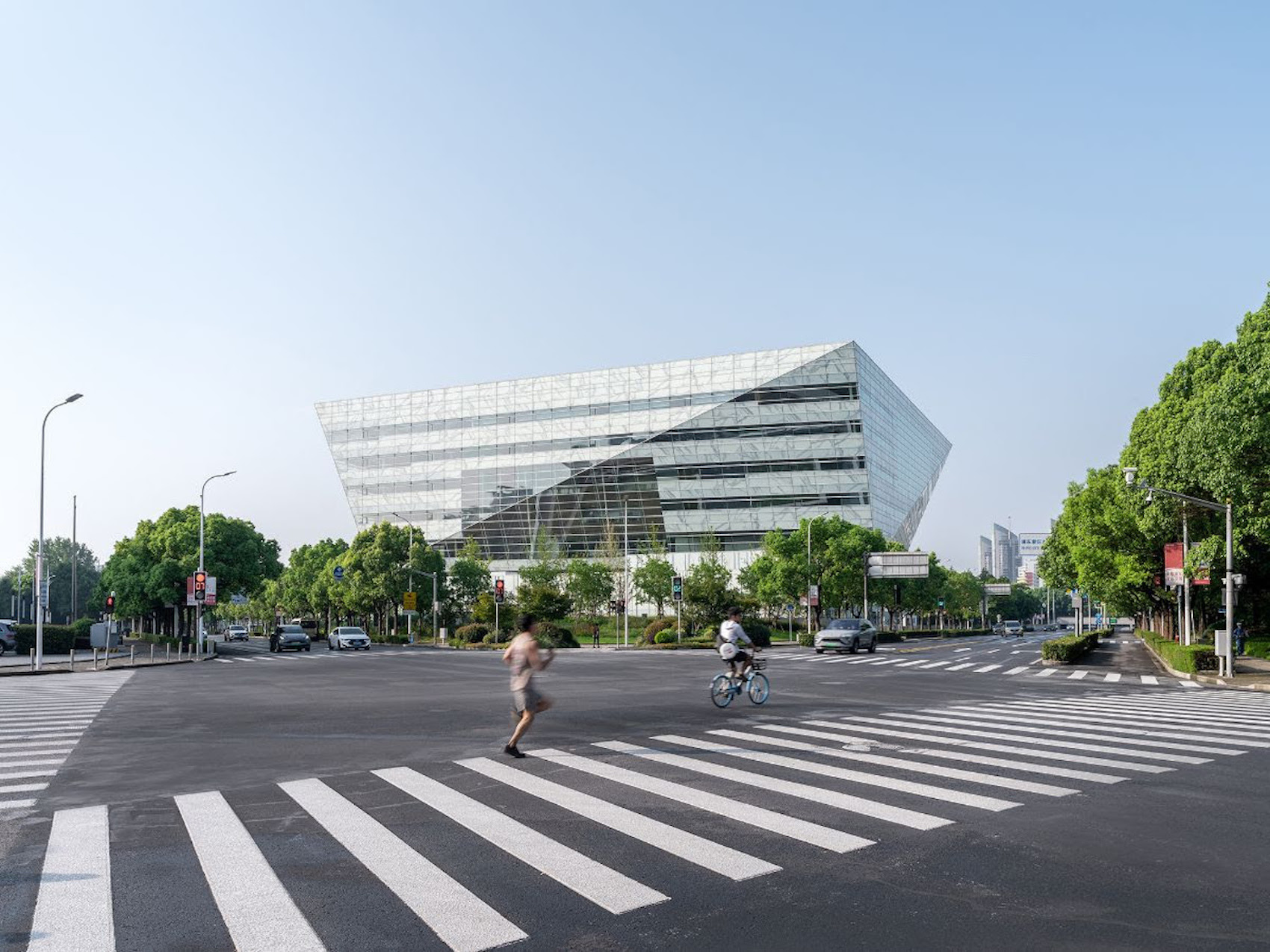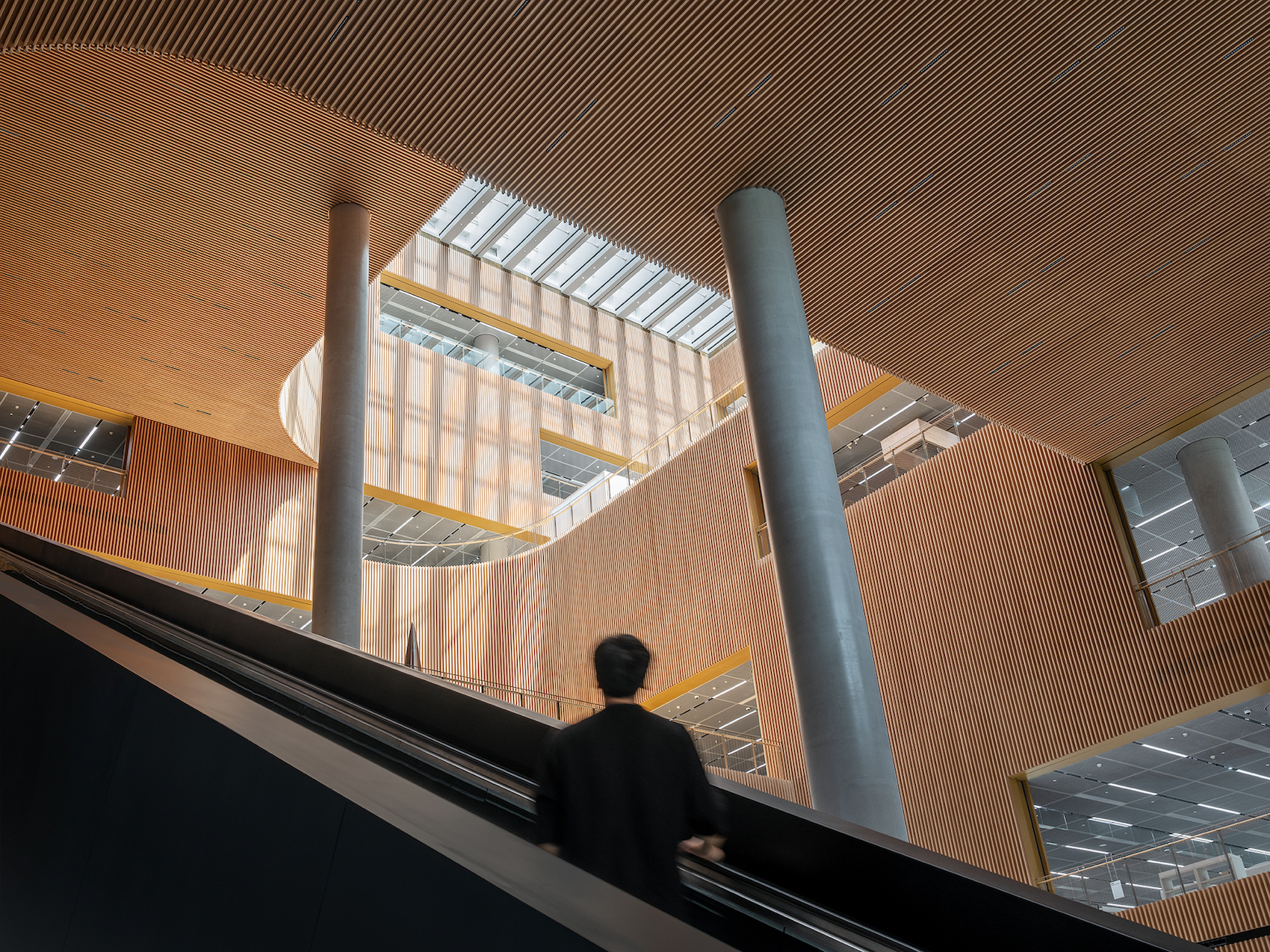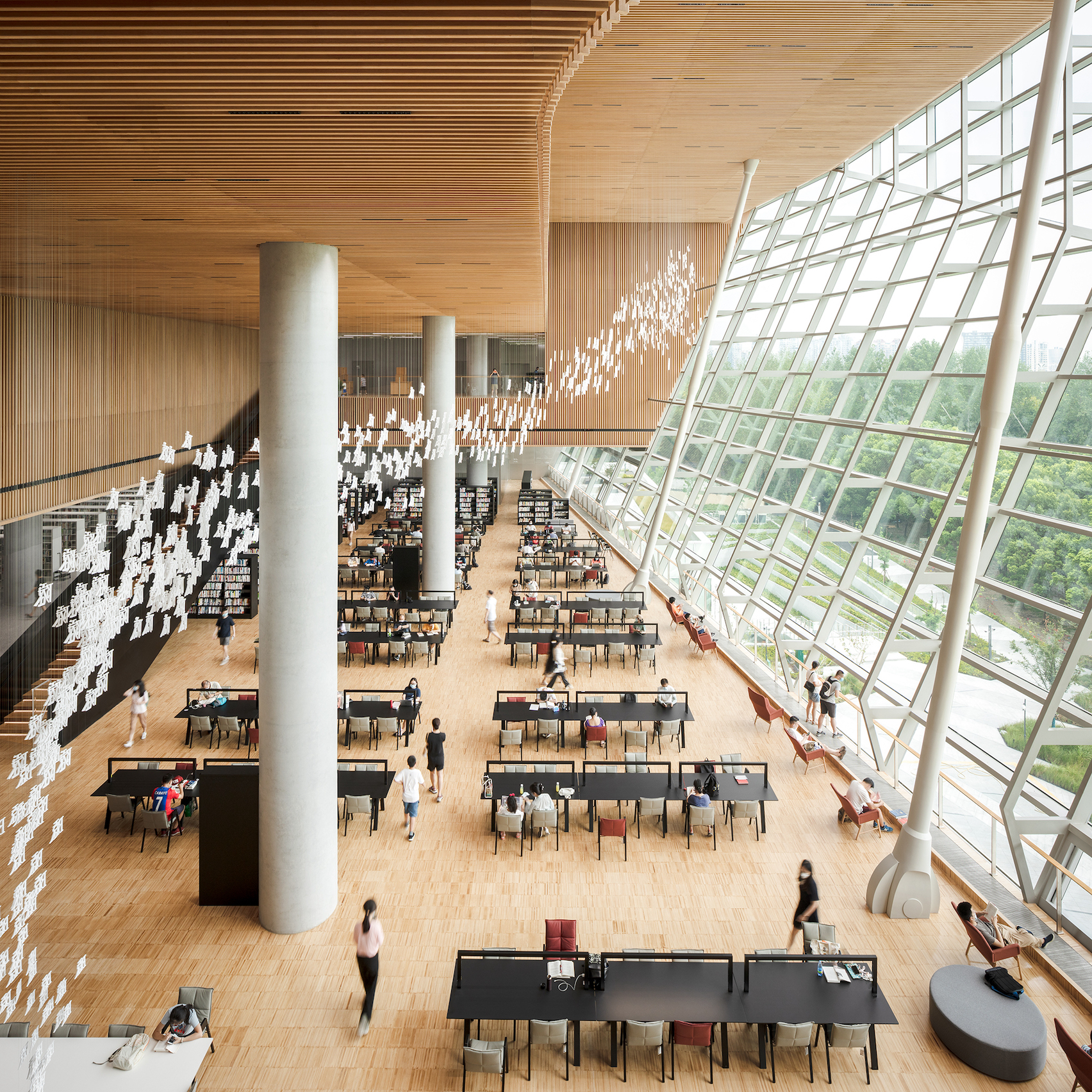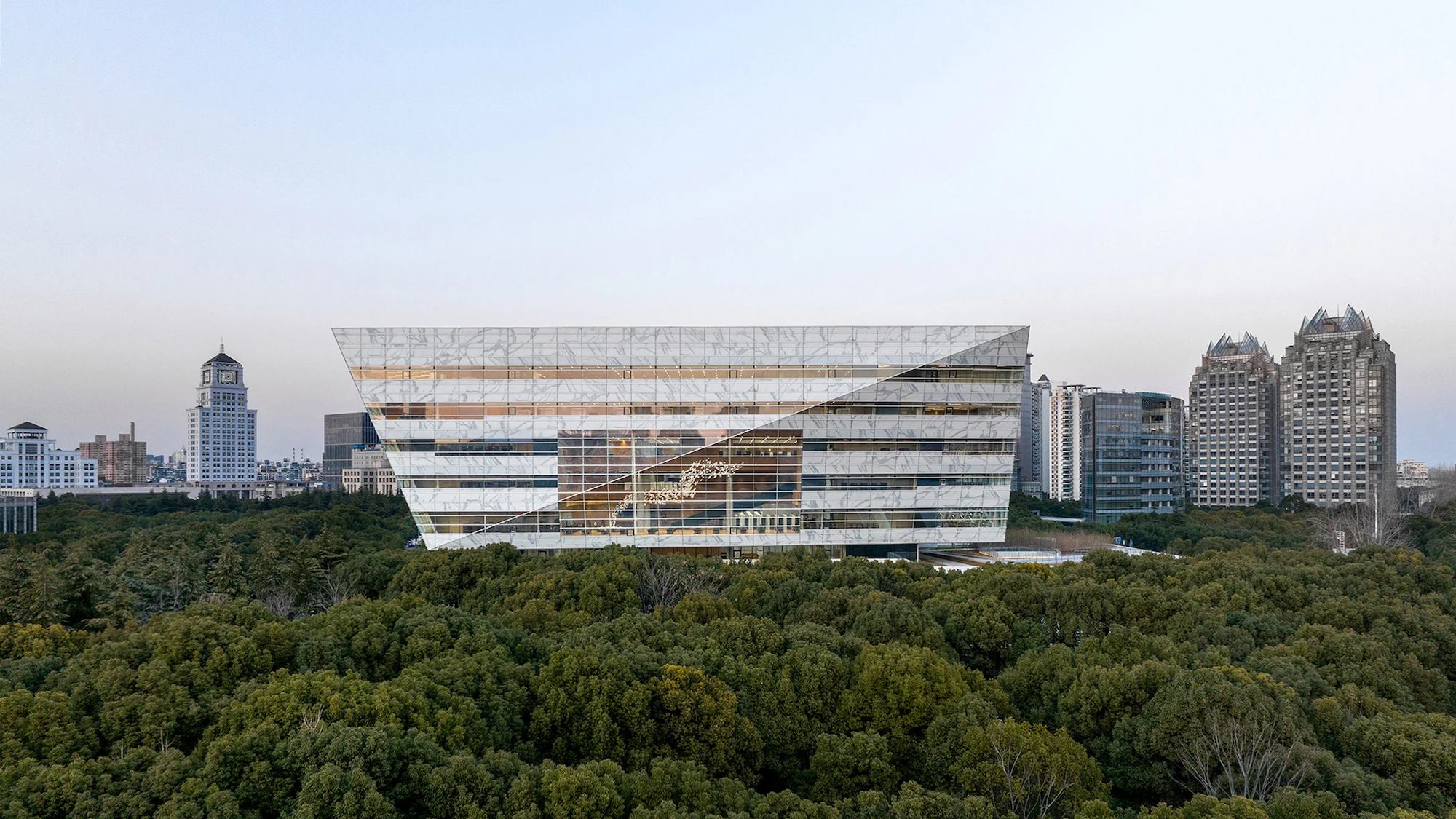One of the world’s largest new libraries has opened in Shanghai. A center of art, culture, and technology-driven learning, Shanghai Library East covers more than 1.2 million sf, more than 80% of which has been dedicated to community activity.
Designed by Schmidt Hammer Lassen Architects (SHL), the building’s architecture and design, with its network of interconnected spaces, evoke the Taihu stones of ancient Chinese scholars.
“In ancient times, scholars would gather around Taihu stones, deriving inspiration from their edges, curvatures, canyons, and tunnels, which seemed to shift when viewed from different vantage points. Similarly, as visitors move about Shanghai Library East, their views of its interconnecting spaces shapeshift,” said Project Architect Jing Lin.
On the library’s exterior glass panels, an abstract motif of marble swirls represents the library’s “cover.” These etched panels, arranged in horizontal bands of varying transparency, allow light into the building.

Outside, the library seems to float above two pavilions: One houses a 1,200-seat theater, exhibition, and events space, and the other houses a children’s library with a courtyard and outdoor play areas. Atop the pavilions are landscaped reading rooms.
On the library’s main level, guests enter a central atrium made of bamboo, oak, and terrazzo. Above, the floors stack and interlock—an architectural strategy that visually connects the library’s seven levels. The lower floor serves as a central plaza hosting events, exhibitions, a bookstore, and a cafe. In addition to its roughly 4.8 million books, Shanghai Library East will host more than 1,200 lectures, seminars, performances, events, and other activities for upward of 4 million visitors per year.
Since opening in 2011, SHL’s Shanghai studio has expanded to 100 staff members—the result of both organic growth and a 2018 partnership with global architecture and design firm Perkins&Will.
On the Building Team:
Owner: Shanghai Library
Architecture firm: Schmidt Hammer Lassen Architects
Local architect: Arcplus Institute of Shanghai Architectural Design & Research
Landscape: ASPECT Studios
Structure consultant: Schlaich Bergermann Partner
MEP consultant: Buro Happold
Sustainability consultant: Transsolar

Design essay from Schmidt Hammer Lassen Architects
Here is more on the library's design from the Schmidt Hammer Lassen Architects team:
A Scholar’s Rock in a Chinese Garden
Taihu stones, or scholars’ rocks, served as muses for the Jin dynasty intelligentsia—sources of creative inspiration and meditation. They were prized for their abstract qualities, perforated surfaces, eroded hollows, and unique textures. In its architecture, interior design, and programming, Shanghai Library East evokes a scholar’s rock in a Chinese garden: a polyhedral stone enveloped in an emerald tree canopy; a naturally occurring network of interconnected interior spaces; a wellspring of knowledge, inquiry, and discovery.
“This library was a unique opportunity to reinterpret a cherished Chinese symbol through architecture and design,” says project architect Jing Lin. “In ancient times, scholars would gather around Taihu stones, deriving inspiration from their edges, curvatures, canyons, and tunnels, which seemed to shift when viewed from different vantage points. Similarly, as visitors move about Shanghai Library East, their views of its interconnecting spaces shapeshift.”
The library’s exterior pays homage to printed literature through an even subtler symbolism. An abstract motif depicting 15 photographs of marble swirls “printed” onto the façade’s glass panels represents the library’s “cover.” Arranged in horizontal bands of varying transparency, these etched panels allow light to penetrate deep into the building, illuminating the space—and, like a good book, enlightening the mind.
A Place for the People of Shanghai
Although it houses multifarious books, Shanghai Library East will also host more than 1,200 lectures, seminars, performances, events, and hands-on activities for upward of 4 million visitors annually. This panoply of programs will be facilitated by 1.2 million square feet of open, flexible, and interconnected environments.
On the main level, a grand central atrium welcomes guests into a vast yet warm and inviting atmosphere of bamboo, oak, and terrazzo. Overhead, the floors stack and interlock—an architectural strategy to visually connect each of the library’s seven levels. The lower floor serves as an agora, or central plaza, hosting various events, exhibitions, a bookstore, and a café.

“Libraries have long formed the backbone of many communities, becoming an integral part of our lives. It’s why we refer to them as the ‘third space’—a highly personal place that exists between our home and our work,” Hardie says.
From the exterior, the library appears to “float” above two pavilions—one housing a 1,200-seat theater, exhibition, and events space; the other housing a children’s library with a central courtyard and outdoor play spaces. Atop the pavilions are outdoor landscaped reading rooms with roofs to protect visitors from rain. Visitors enjoy panoramic views of the iconic Shanghai skyline and Century Park, the city’s largest green space.
"The smart and hybrid Shanghai Library East is a new generation library. It is not only a place for storing and lending books, or a reading room, but also an open space for culture and art,” says Chen Chao, director of the Shanghai Library. "Exhibitions, lectures, music, art, experiencing technologies, and even entering the library itself are seen as a kind of 'reading.’”
Connecting Community with the Arts
Local artists were integral to the design process. Ten contemporary artists from China and abroad—including Xu Bing, Gu Wenda, Shen Fan, Zheng Chongbin, Emily Floyd, Ni Youyu, Mia Liu, Plummer & Smith, Simon Ma and Yang Zhenzhong—created site-specific permanent installations. Curated and realized by the international arts consultancy and manufacturing company UAP (Urban Art Projects), the public artwork program is rooted in the theme “Mediums: The Development of Writing.” The works are intended to inspire readers, encourage communication, and celebrate knowledge.

“The public art vision for the Library, to create an unprecedented collection that befits an institution devoted to education, study, and the archive of texts, has been an essential guide in the realization process,” says UAP’s principal Dane Currey, who oversaw the curation and delivery of the art program for Shanghai Library East. “To have been able to guide the artists and accompany the commissioner and their architects in this journey of conceptualization, experimentation, and realization has been an honor.”
A Legacy of Leadership in Library Design
The completion of Shanghai Library East marks two significant milestones for SHL. First, it caps a decade of success since the opening of the firm’s Shanghai studio in 2011, which has since expanded to 100 staff—the result of organic growth and a 2018 partnership with global architecture and design firm Perkins&Will. Second, it culminates several years of global leadership in library design, from the Royal Danish Library and Dokk1 in Denmark, to Halifax Central Library in Canada, to Christchurch Central Library in New Zealand, to State Library Victoria in Australia.
“Our creative approach to library design is founded on the idea of libraries as inclusive cultural institutions deeply embedded in their context,” says SHL partner and design principal Elif Tinaztepe. “Our clients and community members are true partners who help visions become reality. We ideate with citizens, businesses, governments, academics, historians, students, and other interest groups. And we insist on open, honest dialogue to meet the challenges that can arise at all phases of the project, together.”
The Danish firm has a strong presence in North America with several completed projects, and through its partnership with Perkins&Will. SHL is currently leading the design of the Commonwealth Pier in Boston, and together with Perkins&Will the two firms are designing the new Gateway building for the University of British Columbia in Vancouver.
Related Stories
| Jul 18, 2014
Top Engineering/Architecture Firms [2014 Giants 300 Report]
Jacobs, AECOM, Parsons Brinckerhoff top Building Design+Construction's 2014 ranking of the largest engineering/architecture firms in the United States.
| Jul 18, 2014
Top Engineering Firms [2014 Giants 300 Report]
Fluor, Arup, Day & Zimmermann top Building Design+Construction's 2014 ranking of the largest engineering firms in the United States.
| Jul 18, 2014
Top Architecture Firms [2014 Giants 300 Report]
Gensler, Perkins+Will, NBBJ top Building Design+Construction's 2014 ranking of the largest architecture firms in the United States.
| Jul 18, 2014
2014 Giants 300 Report
Building Design+Construction magazine's annual ranking the nation's largest architecture, engineering, and construction firms in the U.S.
| Jul 7, 2014
7 emerging design trends in brick buildings
From wild architectural shapes to unique color blends and pattern arrangements, these projects demonstrate the design possibilities of brick.
| Jul 2, 2014
Emerging trends in commercial flooring
Rectangular tiles, digital graphic applications, the resurgence of terrazzo, and product transparency headline today’s commercial flooring trends.
| Jun 30, 2014
Research finds continued growth of design-build throughout United States
New research findings indicate that for the first time more than half of projects above $10 million are being completed through design-build project delivery.
| Jun 18, 2014
Arup uses 3D printing to fabricate one-of-a-kind structural steel components
The firm's research shows that 3D printing has the potential to reduce costs, cut waste, and slash the carbon footprint of the construction sector.
| Jun 16, 2014
6 U.S. cities at the forefront of innovation districts
A new Brookings Institution study records the emergence of “competitive places that are also cool spaces.”
| Jun 12, 2014
Austrian university develops 'inflatable' concrete dome method
Constructing a concrete dome is a costly process, but this may change soon. A team from the Vienna University of Technology has developed a method that allows concrete domes to form with the use of air and steel cables instead of expensive, timber supporting structures.
















